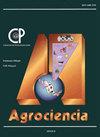IDENTIFICATION OF OUTSTANDING SALADETTE TOMATO LINES WITH A WIDENED GENETIC BASE
IF 0.5
4区 农林科学
Q4 AGRICULTURE, MULTIDISCIPLINARY
引用次数: 0
Abstract
The “bell pepper” or “chino criollo” tomato is a native Mexican variety with similar characteristics to the “Saladette” tomato and the potential to be used as a source of germplasm to generate commercial hybrids of this type. The aim of this investigation was to identify and select advanced lines with a wide genetic base, derived from crosses between Saladette tomatoes and native populations to generate free pollination varieties and potential parents of Saladette tomato hybrids. The hypothesis was that crosses between native populations and Saladette commercial hybrids generate outstanding offspring. The 103 genotypes evaluated included 10 native parents, three parents derived from commercial hybrids, one commercial hybrid control (“El Cid”) and 89 S4 advanced lines. The evaluation was carried out in a greenhouse and hydroponics during the 2020 spring-summer cycle, using a randomized complete block experimental design with three replications and four plants per replication. The total weight and number of fruits were recorded based on the sum of the two cuts performed. The days to flowering of the first cluster, average fruit weight, and total soluble solids were also determined. Analyses of variance were carried out for each variable, as well as orthogonal contrasts and correlations between different combinations of the materials of interest. The comparison of means was carried out using Tukey’s test (p ≤ 0.05). Nine advanced lines with similar or greater characteristics to the control were identified and are recommended to be recombined genetically in a diallelic cross scheme to identify new outstanding offspring. The advanced line 2051 (LOR85 X C) was identified, with a similar yield to that reported for the control, which can be used as an open pollination variety since it has similar characteristics to the control “El Cid”, but with native tomato genes.扩大遗传基础的萨拉多特番茄优良品系鉴定
“甜椒”或“chino criollo”番茄是一种墨西哥本土品种,具有与“Saladette”番茄相似的特征,并且有潜力作为种质资源来产生这种类型的商业杂交品种。本研究的目的是鉴定和选择具有广泛遗传基础的高级品系,从萨拉黛特番茄与本地群体的杂交中获得自由授粉品种和潜在的萨拉黛特番茄杂交亲本。他们的假设是,本地种群和萨拉黛特商业杂种之间的杂交产生了优秀的后代。103个基因型包括10个本地亲本、3个商业杂交种亲本、1个商业杂交种对照(“El Cid”)和89个S4高级系。采用随机完全区组试验设计,3个重复,每个重复4株,于2020年春夏周期在温室和水培中进行评价。根据两次切割的总和记录果实的总重量和数量。测定了第一簇的开花天数、平均果实重量和总可溶性固形物。对每个变量进行方差分析,以及正交对比和不同感兴趣材料组合之间的相关性。均数比较采用Tukey检验(p≤0.05)。鉴定出9个与对照性状相近或更大的高级品系,建议采用双等位杂交方案进行遗传重组,以鉴定出新的优秀后代。经鉴定的先进品系2051 (LOR85 X C)产量与对照相近,具有与对照“El Cid”相似的性状,但具有本地番茄基因,可作为开放授粉品种使用。
本文章由计算机程序翻译,如有差异,请以英文原文为准。
求助全文
约1分钟内获得全文
求助全文
来源期刊

Agrociencia
农林科学-农业综合
CiteScore
0.50
自引率
33.30%
发文量
51
审稿时长
18-36 weeks
期刊介绍:
AGROCIENCIA is a scientific journal created and sponsored by the Colegio de Postgraduados. Its main objective is the publication and diffusion of agricultural, animal and forestry sciences research results from mexican and foreign scientists. All contributions are peer reviewed. Starting in the year 2000, AGROCIENCIA became a bimonthly and fully bilingual journal (Spanish and English versions in the same issue). Since 2007 appears every month and a half (eight issues per year). In addition to the printed issues, the full content is available in electronic format.
 求助内容:
求助内容: 应助结果提醒方式:
应助结果提醒方式:


